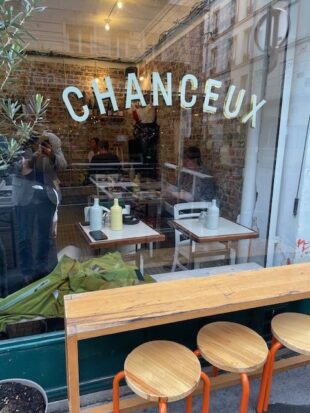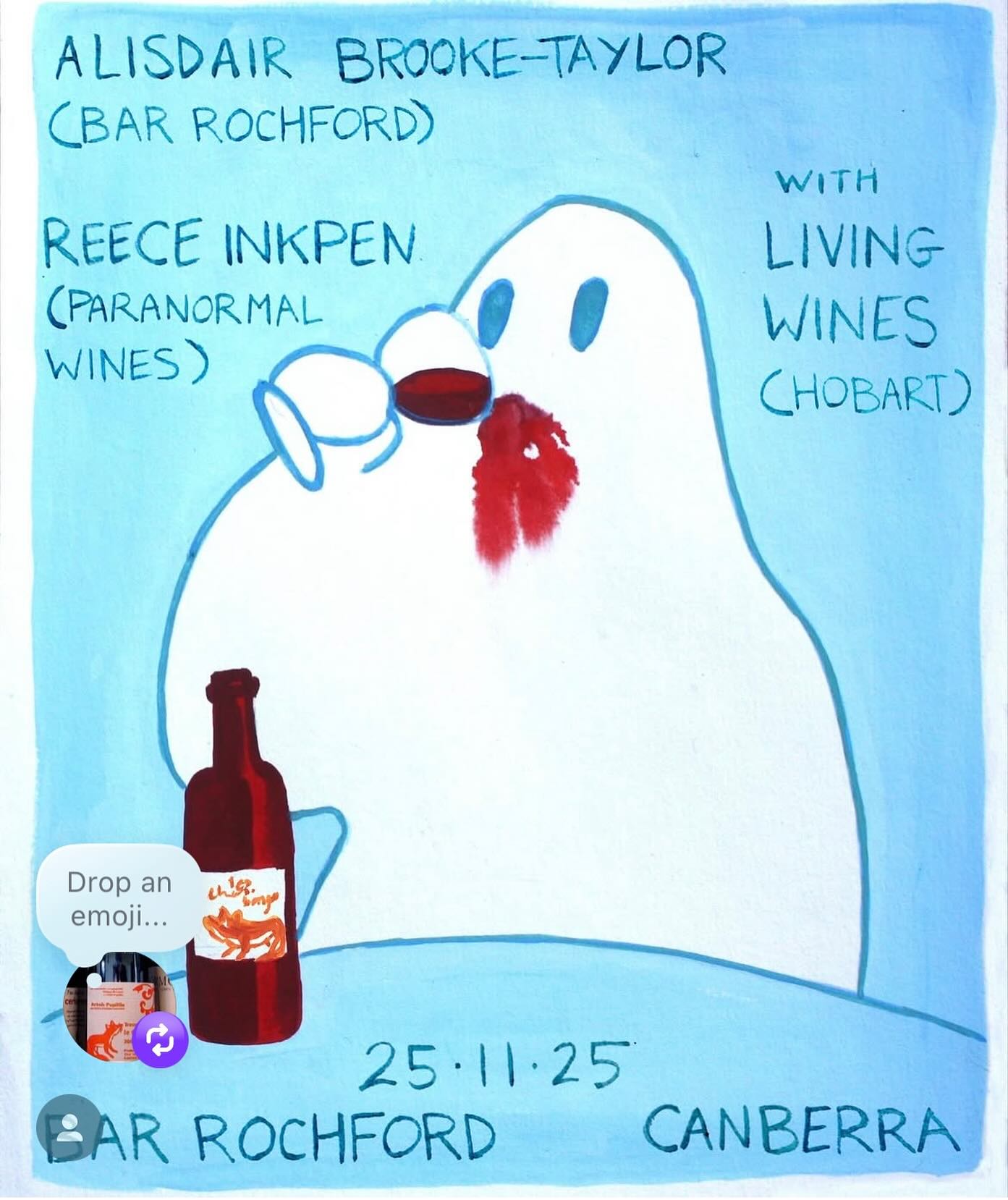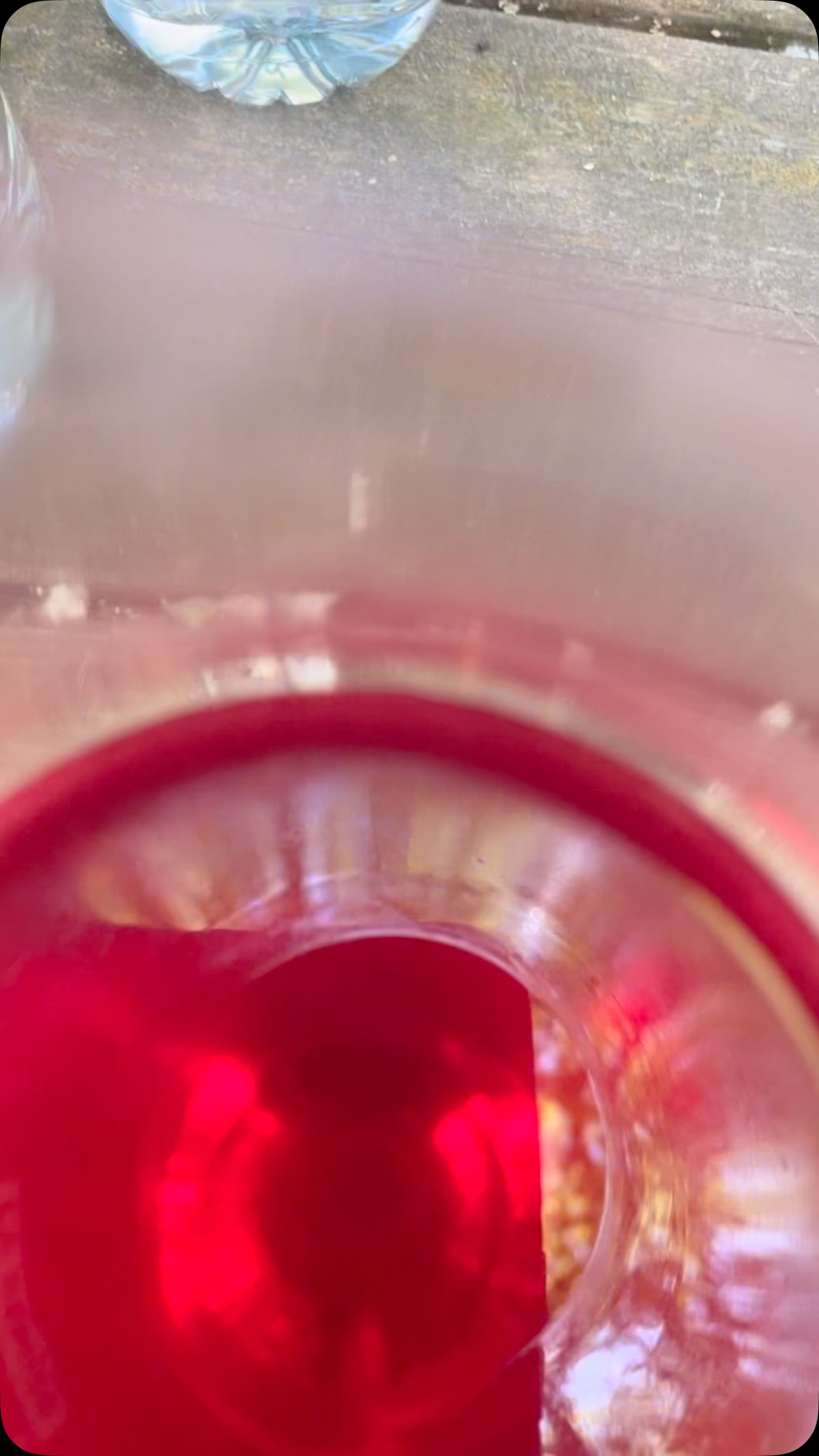France and London natural wines and food – 2024
This is a short account of our annual tour around France (and London this year) visiting the natural wine producers whose wines we import to Australia and visiting restaurants and bars that specialise in natural wines to see what they are serving, which producers they favour and what types of wine their customers are enjoying most.
So, this story is an account of the visits
which we undertook in June and July 2024. It was an unusual time for us to visit because we normally find France far too hot at this time of year, but it was a convenient time for our business being in between wine shipments arriving in Australia.
Phase 1 – London
We flew to London first and spent a couple of enjoyable days there revisiting some old favourites and catching up with friends at some new restaurants and bars. We arrived early morning and the day was clear and not too hot so we decided to have a light lunch at Rochelle Canteen which we had dined at on a previous visit.
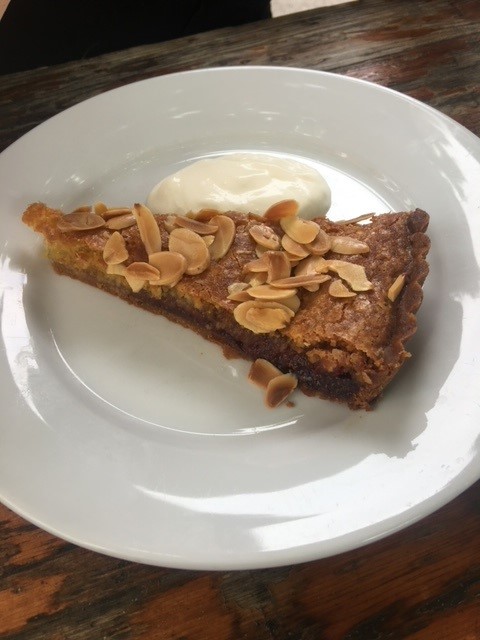
The photo above is of a slice of tart we enjoyed for dessert
Our meal there was mainly based on vegetables and they were cooked beautifully and presented without too much fuss. It was very pleasant sitting outside and we enjoyed our time there very much.
On our way to dinner we made a slight detour to catch up with a person who had been around the natural wine scene in Australia and Japan for some time and who has now opened a wine bar in London called Yuki Bar. His name is Yukiyasu Kaneko, but everyone seems to call him Yuki (including himeself).

We very much enjoyed our short visit where we, on Yuki’s recommendation, tasted a couple of very interesting natural wines. One was the Mensonge a Papa from Belly Wine Experiment in the Auvergne. Made from Gamay, this wine was both delicate and full of flavour with the Gamay contributing depth without too much tannin getting in the way.
We also noticed on the list a Sylvaner Origin from Jean-Marc Dreyer in Alsace which we would recommend highly – it is one of the wines we import from that part of France and all his wines are memorable.
We also managed to enjoy a couple of Yuki’s snacks even though we were soon to have dinner. One was a beautiful dish of tomato, shiso and rhubarb where each of the components added a complexity to the dish which was very harmonious. The other was a dumpling dish of potato and kimchi.
We decided that this was a great place to hang out and to try interesting dishes and wines from far and wide that we may not have tried before.
We hadn’t caught up with our friend Jonathan Alphandery in a while so we were anxious to meet up with him in his relatively new restaurant, Planque, knowing that he had an excellent chef on board and he always has a very serious cellar available including some much sought after natural wines.
We loved everything we tried that night, right from the first dish of oysters to the final dessert dish described below. It was a great experience.
The dishes were generally presented without contrivance letting the produce speak for themselves, such as you can see from the dish of veal sweetbreads teamed with greens that was a stunning combination of flavours and textures.

One of the dessert dishes was an absolutely beautiful reimagining of the famous Mont Blanc chestnut specialty. Here the puree was presented between thick layers of perfect pastry. It looked interesting and tasted fabulous.
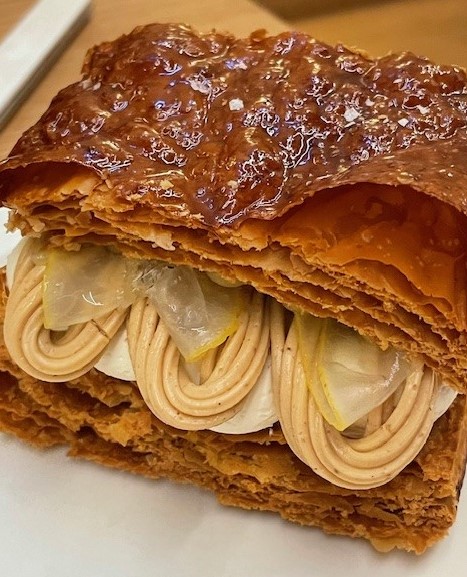
You can see more photos of our meal at Planque in our story about this restaurant here.
The next morning we met up with William Gleave who we had got to know very well when he was working with Luke Burgess as part of the team at Garagistes in Hobart, our home town. We had also eaten at the restaurant in London called P Franco where a scallop dish he served us was one of our all time most delicious and well-rounded plates we have ever been served.
We met for breakfast at a canal-side eatery called Towpath which we had heard good things about and since it was a very pleasant day was perfect for sitting outside next to the Regent’s Canal in East London.
This venue is run by Laura Jackson (chef) and Lori de Mori and it appears to be insanely popular especially in the summer months. By coincidence Laura was also the chef for a season at one of our favourite venues in France, namely Auberge de Chassignolles back in the time when it was owned by Harry Lester.
The menu was interesting and we felt that we could have chosen every dish, but we still had a lot of eating to do that day, so we restrained ourselves somewhat!

The dish of granola with yoghurt and strawberries was remarkable for the vibrancy of the strawberries (and a few raspberries) as they perched on top of the other ingredients. Have a look.

We also thoroughly enjoyed the Indian-influenced dish of masala dal and condiments which was very tasty and very flavoursome – a perfect breakfast dish.
The coffee was very good also.
That evening we decided to do a re-visit. There are always a few restaurants in any city that we always want to return to. In Sydney we seem to revisit Ester every time we go to that great city. In Tokyo it is Bunon. In Hong Kong it is La Cabane and The Chairman. In Melbourne it is Cam Burton’s Public Wine Shop and Jean-Paul Prunetti’s France Soir. In Paris it is Le Doyeneé, in Marseille it is La Mercerie and in Nice it is always La Merenda. In Seattle we always check out the French charm at Le Pichet.
When we visit London, the place we return to seems to be Brawn – we are always attracted to the delicious food and friendly service. The beautiful building that houses Brawn is shown below:
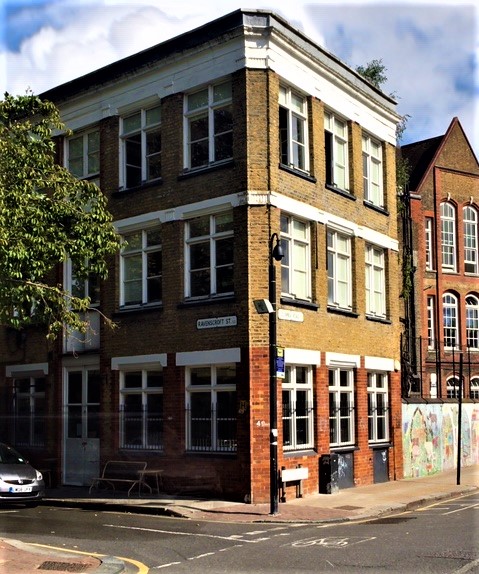
We had a very pleasant evening there (immediately opposite Ravenscroft Park) enjoying the wonderful service, food and wine. During one past visit we can vividly remember Phil Bracey pouring Castex Canta Manana from a magnum – a class act!
They even have a similar board on the wall to the one at Chateaubriand listing some of the producers they have had available.
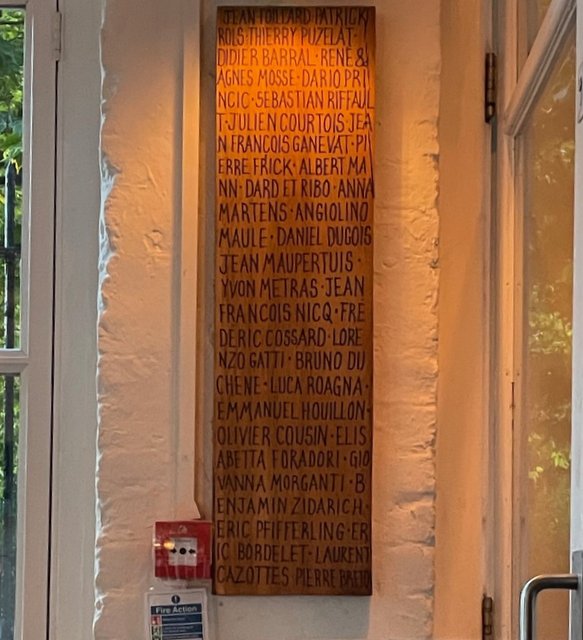
You can see famous natural wine producers such as Didier Barral, Rene and Agnes Mosse, Julien Courtois, Francois Ganevat, Anna Martens (from Australia now working in Sicily), Yvon Metras and Eric Pfifferling listed on the board shown above.
Our meal consisted of a number of shared plates including panisse, a peach and greens salad, raw chopped beef, agnolotti, veal belly and panna cotta for dessert. We have added some photos of this delicious meal to our story about Brawn here.
Our last venue was lunch at Leo’s Restaurant and Bar which is about three kilometres north-west of Brawn towards Hackney Marshes. They have a good range of natural wines from Italy (the chef is Sardinian), Spain and France including two of our wonderful producers namely Michel Guignier from Beaujolais and Mataburro from Roussillon.
Our meal was simple with the pasta being outstanding and well worth the small journey into an area we hadn’t been to before. We then rushed off to the train station to catch the train to Paris for the next part of our adventures.
We are going to add one more restaurant in this Phase even though it is out of sequence. The reason is that we also flew out of London after six weeks touring around France. This gave us the opportunity to have a liesurely lunch before catching the plane to Australia that evening.
Our meal was at a place we hadn’t been to before called Quality Wines in the suburb of Farringdon, which is also in the east-ish part of London. The food here was quite delicious and the wines available were exactly the type of wines we like.
The wine that we chose was an old favourite that we have been drinking since we first discovered it in the early 2010s. It was Love & Pif by one of the masters of Burgundy wines, namely Yann Durieux. From the very first time we took a sip of this wine we were delighted with his mastery of the Aligoté grape variety.
Phase 2: Paris
On this visit we didn’t stay very long in Paris due to the Olympics, which we tried to avoid as much as possible.
Once we arrived in Paris our thoughts turned to ice cream and also to our favourite restaurant Le Doyenné. We had already reserved a table for lunch at the latter the next day so that evening we headed for the incredibly popular Folderol to try their ice creams and wines.
When we arrived there was a crowd milling around the door waiting to get in or enjoying their ice cream and wine in the street. One advantage of advancing age is that the person on the door decided that we needed to sit down, so found us a prime place inside where we were able to talk to the sommelier about the types of wine we like, so we ended up enjoying a bottle of the Geschickt First Drop and a couple of delicious plates of ice cream – we particularly liked a plain vanilla ice cream made with vanilla from Uganda.
The next morning we headed to a place we hadn’t visited before – it is a bright and cheery cafe at 57 Rue Saint-Maur (quite close to the ever popular La Buvette) in the 11th that serves what we think is one of the best breakfasts in Paris. It is called Chanceux. There is another outlet at 63 rue Galande.
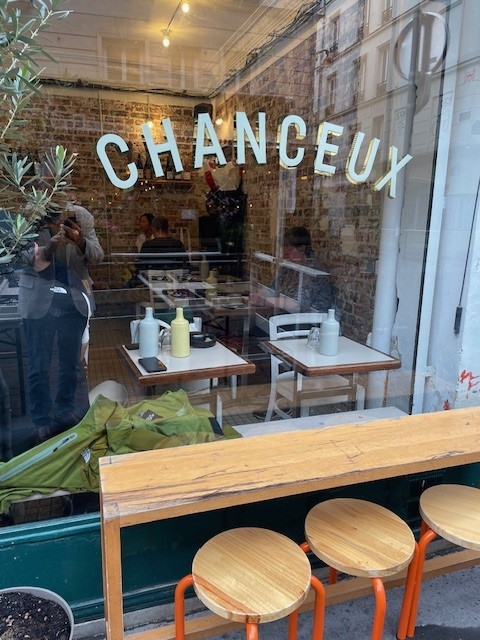
The breakfasts are filling and enjoyable and the coffee is very good. An example of the breakfast offerings is shown below.
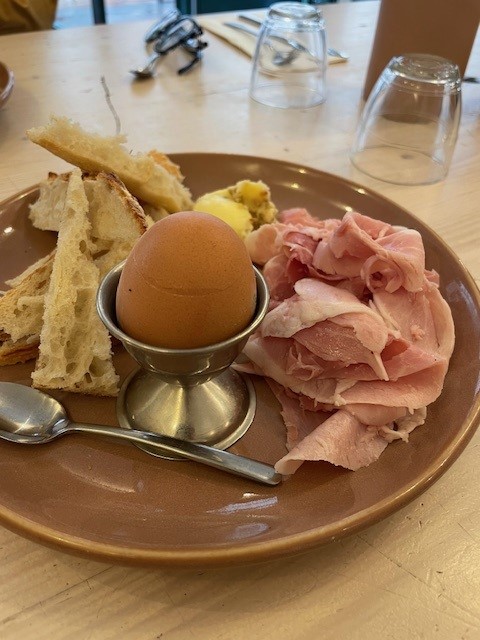
A perectly soft boiled egg accompanied by slices of fresh baguetter accompanied by slices of cheese and ham.
We then headed for Le Doyenné to catch up with James Henry and Shaun Kelly, two Australian chefs who have worked incredibly hard to create this amazing restaurant in the grounds of an historic chateau some 50 kilometres south of the centre of Paris.
The meal we had this time was as good as our previous visit and we will be adding a survey of the dishes to our story about this excellent venue on this site here.
Another bonus for us was catching up with our friend from Hobart, Bianca Johnston, where she was a key member of the kitchen team at the legendary Tom McHugo’s pub. She is now enjoying working in a different country with the team from this exceptional restaurant.
We returned to Paris after our delicious meal in order to revisit a restaurant where the Sunday lunch highlights the skill of the chef in making terrines of varying types – Repaire de Cartouche (also in the 11th).
On our way to lunch we dropped into one of our favourite coffee places – this time in rue Oberkampf. It is one of the coffee outlets set up by Hippolyte Courty, namely l’Arbre a Cafe (he has another in the 2nd). They have an amazing selection of beans from all over the world making it easy to choose something to your liking. We chose beans from the Marin family in Peru who had included in the mix Catimor, Bourbon, Caturra and Typica varieties.

It is amazing how the coffee from both Peru and Colombia is rivalling some of the great countries of Africa – the proximity to the equator and the height of the Andes mountains providing a very stable climate for growing exceptional coffee beans.
After our coffee and on our way to Repaire de Cartouche we passed another of our favourite places, Aux Deux Amis, the wine bar set up many years ago by David Loyola. We have enjoyed many wonderful evenings at this exuberant venue where the food has been prepared in the tiny, tiny kitchen by a number of interesting chefs over the years who have gone on to other interesting places throughout France and beyond.

The chefs have included Svante Forstop who also has cooked with Pierre Jancou among others, Mathieu Pérez who went on to cook at Percheron in Céret (where we loved the food), the famed Bar Brutal in Barcelona and now has his own restaurant there, Tatiana Levha who went on to open Le Servan only a couple of blocks up the hill and Romain Tischenko to name just a few.
Le Repair de Cartouche is where the gregarious and talented chef, Rodolphe Paquin oversees the lunch. He is an expert terrine maker as well as the author of an excellent book on the topic. The lunch highlights a number of his amazing terrines as well as roast chicken and some delicious desserts, including a chocolate dessert with very fresh strawberries.! He also has a very strong lineup of non-interventionist wines.
Our meal at Repaire de Cartouche was exactly what we expected with dish after dish placed on the counter for guests to peruse. We loved the small dishes and the pieces of terrine which had been sliced to reveal their contents. We also couldn’t resist a beautiful dish of white asparagus which had been cooked perfectly. The main course was a splendid piece of roast chicken with various accompaniments followed by a delicious dessert. 8 boulevard des Filles du Calvaire, 75011.
Clove Coffee was the last place we visited in Paris before heading out to the country. This is a very special coffee venue which sits comfortably in the space between the obsessive and the everyday venues. Here they take the coffee very seriously without being too judgemental. They list the options on the wall behind the servers. Here they allow you to have milk (including vegetal and vegan) in your coffee (not that we do) and also allow you to enjoy some very nice tarts, cakes and pastries supplied by some of the best (think Cristophe Louie) with your drink. We are looking forward to another visit on our next trip to France.
On the next day we caught the train to Angers where we established a base for visiting some of our winemakers including the Robinot family and the Mosse family.
Our first meal in Angers was at a new restaurant which is in the space previously occupied by Un Ile, a restaurant that we used to visit often. It is now called Gribiche after the famous French sauce, and we had booked there for our first night in Angers.
We then returned to Paris, visited a wonderful restaurant and then caught the train to Perpignan in Roussillon which is in Catalan country. We will give a full account of our eating adventures outside Paris in a separate posting.
However we must end with a description of the delicious meal that we had at Cheval d’Or in the 19th and our coffee experience prior to catching the train.
Cheval d’Or is the restaurant where Filipino-Australian chef Hanz Gueco is currently showing Paris just what a talented chef he is and what a loss he is to Australia. We were delighted with out meal where we revelled in dishes such as quenelles of merlu with sauce nantua which was followed by an amazing dish of tortellini ragu with mapo sauce both of which can be seen below.

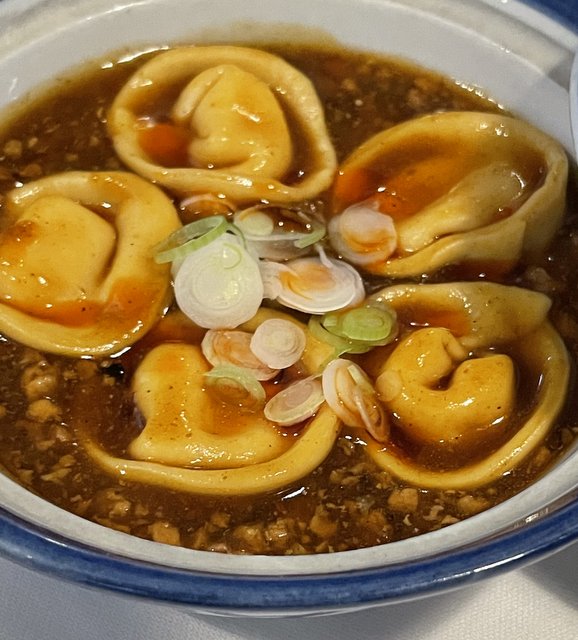
Next morning prior to catching the train to Perpignan we caught the train to the 18th to try the coffee at Clove Coffee which is a relatively new outlet where we were delighted with the selection of beans to choose from and the professional manner in which our coffees were prepared. We will create a separate entry for this excellent addition to the Paris coffee scene.
Phase 3: Loire Valley
So, three days in Angers! The first day was easy because we arrived late in the afternoon and we had already booked at a relatively new restaurant in a site that had housed a restaurant that we have written about regularly called Une Ile at 9 rue Max Richard. It is now under different people and the name has changed to Gribiche in honour of the famous French sauce.
Gribiche
We arrived here early in the evening for our booking with the anticipation which is always present when we have booked at, for us, a new restaurant.
We started the evening with a Cantillon beer (we like beer that has been fermented naturally – it is not easy, but the results are worth it) which as always was excellent. We then switched to an Aida from the Mosse family made from direct press Savagnin which was planted by Sylvestre and Joseph about five years ago. This was to accompany a dish of pressé de museau persillé served with, as you might expect, sauce gribiche. Both the wine and the snout were excellent with the sauce gribiche showcasing the chef’s saucing skills.
We will provide a more extensive review of our meal on this site shortly!
Robinot Family
The next day was taken up with a trip to the Robinot family, whose stunning wines we have been importing to Australia for many years. They live in the village of Chahaignes which is about 50 kilometres north of the city of Tours. We always look forward to our visits here to try the new wines made with skill and understanding of the processes required to make long-lasting wines without the need to add sulphites.
Mosse Family
The next day our visit was to the Mosse family whose operations are about 30 kilometres south of Angers. We had a very nice time there as always, discussing the new wines that Sylvestre and Joseph were making. We also met up with Agnès and René, who were two of the first group of producers of natural wines that we imported to Australia.
That night we enjoyed the weather in Angers sitting outside the famous Le Cercle Rouge (a compulsory natural wine stop) wine bar in which Joseph now has a part ownership.
Le Cercle Rouge
Le Cercle Rouge has been a regular drinking venue of ours for many years. It is one of a number of long-lasting natural wine bars in France that have similar characteristics. These venues, such as Le Cercle Rouge along with Bistrot des Claquets in Arbois in the Jura, Aux Crieurs de Vin in Troyes, Les Becs A Vin in Orléans, Aux Deux Amis, Septime La Cave and La Buvette in Paris, La Part des Anges in Nice, Les Vins des Vivants in Lyon and l’Echanson in Nancy all show an “easy” permanence through the provision of wines that their customers want to drink and tasty, yet not tricked up food to snack on while enjoying the wines.
Others are emerging and will take their place alongside these iconic bars, for example Marie Pimprenelle’s venture in Sete called Pimpant, Micro Sillon in Lyon and Lise and Bertrand Jousset’s lovely l’Ephémére bar in Montlouis-sur-Loire.
Coffee in Angers
While we were in Angers we made sure we visited our two favourite coffee places, namely Café Cardinal and Le Grain Perché which are two very different venues but each produce interesting coffees.
Cave Saint Aubin
Another venue that we try to visit as often as possible in the tiny Cave Saint Aubin which has derived its name from the street it is in.
We found Cave Saint Aubin, many years ago when we used to attend the winter salons in nearby ??.
We were amazed when we first walked in and were presented with an array of natural wine luminaries such as Fanny Sabre, Casot des Mailloles, La Ferme des Caudalies, Alexander Bain, Bruno Rochard and Domaine Marechal among many others.
More recently they have been lining up wines from much further afield including Domaine de Ardoisieres from the Savoie who make excellent wines from their vineyards where they harvest grapes such as Mondeuse, Jacquere, Persan and Altesse among others!
Recently we have also seen wines from Xavier Courant, Chateau St Anne in Bandol, Champagne Louise Brison, our friends Alice and Olivier de Moor who make beautiful wines in Chablis and other nearby appellations and Domaine l’Anglore who are based in Tavel among others.
The owner is very helpful and eager to explain as much as you want to know about each producer. 25 rue Saint Aubin, Angers.
On Thursday we caught the train back to Paris in the early afternoon, but that meant we had time for a quick lunch. We had heard some good things about a place in Savennières that served good pizza and has some interesting natural wines available so we headed there for a quick lunch.
Lulu – Savennières
The name of the restaurant is Lulu and Savennières is not very far from Angers (and on the same side of the Loire River) and is a famous wine growing area, made even more famous by the presence of wine guru Nicolas Joly and his daughter Virginie who turn out great wines crafted from their Chenin Blanc grapes such as their Coulée de Serrant from that sub-appellation. We also import a wine from the Mosse family called Arena which they sometimes release under the Savennières appellation.
Now to Lulu. It is a small restaurant with mainly outdoor seating with a menu of snacks and pizzas and a wine list favouring local Savennières producers such as Tessa Roche from Domaine aux Moines. We thoroughly enjoyed our pizza and a glass of wine before rushing off to return our hire car and catch the train to Paris.
Phase 4: Perpignan (Roussillon) and Bédarieux (Languedoc)
Our evening in Paris was an enjoyable meal at Cheval d’Or which we mentioned above. We then caught a train to Perpignan which is in the very south of France on the Mediterranean side quite close to the Spanish border.
We had decided to spend a few days here to enable us to visit three producers as well as try out some of the local natural wine venues.
One restaurant that caught our attention was Manat where the food is interesting, even exciting, and is prepared with cleverness and attention to detail. We fondly remember an entree of haddock served with small potatoes, salicorne and a very tasty sauce of breton fermented milk called lait Ribot.

The dish above was delicious as were the ravioli dish, the bavette with padrones, the pannacotta and the blanc-manger with apricots.
We also decided to drink a local wine and who better than Mataburro? It went beautifully with all the dishes we tried.
Naive
Another place we were impressed with was Naive (which is quite close to a very smart epicerie called Solar where there is a nice selection of fruits and vegetables along with tinned products and some very good wines made by small local producers). The highlight of the meal was the Poisson du Jour Entier (Rascasse) which we enjoyed after working our way through most of the smaller dishes listed on the chalkboard menu. An example of the smaller dishes was the padron peppers that had been grilled over fire.

We liked it so much we returned for dinner on our last night in Perpignan and the dishes we were served were again excellent. Four dishes of seafood for extremely reasonable prices.
Baston
Another great evening was at Baston where we arrived as their two Japanese chefs were trying out a menu where the dishes were mostly (except for their famed pizzas) the dishes that are to be the opening choices for their new restaurant nearby.
Baston is also well-known for their very deep wine list of natural wines. We were very impressed with the selection available here.
Cafe Leo
We have already talked about Cafe Leo in its own entry on this site because it is one of the best coffee places that we have found outside Paris. We were very keen to have another coffee experience here as we had enjoyed ourselves so much on our previous visits.
We were served a Gesha coffee from Colombia – a country which is receiving a lot of attention for the quality of the coffee being produced here due to the proximity to the equator (coffee trees like warmer climes) and the fact that the farmers can take advantage of the heights of the Andes (this one was grown at around 1800 metres above sea level). The beans had been roasted by Kawa in Paris, which is a highly regarded roaster. 1 Rue de la République, 66000 Perpignan.
Yegg
Yegg is an informal, sit outside and enjoy-the-sun type bar that serves a limited, yet very tasty selection of food. On the day we ate there we had to sit inside because the rain was pelting down. However, we ordered a hamburger and it was extremely tasty. It is the type of place that creates a friendly atmosphere while still being very professional about their approach to work! 3 Rue René Paratilla, 66000 Perpignan.

Neo
Neo is a very good bakery in the centre of Perpignan. They have an excellent range of breads of various textures. They also make sandwiches using their bread on request. 15 Rue Pierre Rameil, 66000 Perpignan.

Sign outside Neo in Perpignan

Languedoc)
Phase 5: Nice
Our next stop was in Nice to try out some of the restaurants that we love and to see if there were any wines in the very interesting appellation which sits within the city boundaries. It is interesting for a number of reasons, the first being the site which shares steep hillsides with the suburban sprawl of the city and the second being the permitted grape varieties which are the rare braquet and fuella nera for reds and vermentino for the whites.
We enjoyed revisiting Pure & V, one of our favourite high-end restaurants in France, where we were told by the owner that they were closing early in 2025, so by now it is probably shut.
And, of course, we never visit Nice without a meal at La Merenda – this is a restaurant that is holding up the traditions of the cuisine of Nice and still serving up the dishes as they are supposed to be cooked without any modern so-called “refinements”.
It is therefore one of the few places where you can get a dish of stockfish stew cooked how it has always been done. You can read more about this place in our story about the restaurant here.
We also love Le Canon which is a great bistro serving dishes cooked with wonderful produce especially the vegetables and fish which are served here. They also have an excellent range of wines – all of which are natural and hence free of sprays.
Phase 6: Saint-Saturnin-lès-Apt
Each trip to France we try to visit the quaint village of Saint-Saturnin-lès-Apt to eat at the lovely hotel restaurant at Le Saint Hubert where we sit on the terrace looking out over the valley towards the Luberon hills. the food here is simple but incredibly tasty. We have a story about our meals at this venue here.
While we were in Saint-Saturnin-lès-Apt we took the opportunity to visit another of our producers – this time it was Domaine Milan in the Roman city of Saint-Rémy-de-Provence. They are the only producer which we import that has a tasting centre for visitors so we often recommend that people visiting France drop in here if they are in the general area.
As always the visit was very fruitful and included a tour of some of the vineyards that we hadn’t had the chance to inspect before as well as a tasting of the new vintages to help us with the next order.
We then headed back to Saint-Saturnin-lès-Apt ready for an interesting drive the next day!
Phase 7: Winding trip to the Savoie
On leaving Saint-Saturnin-lès-Apt we headed for the Savoie through some of the most spectacular scenery you are likely to see anywhere. This is where the olive trees of Provence peter out and the walnut trees begin to appear.
This is where the roads are no longer straight but instead are contorted into sharp corners as they climb up over the many mountains that punctuate the landscape.
Our first destination was the pleasant town of Forcalquier where we went searching for a restaurant called Le Bas Alpin which we had heard good things about.
We arrived at the restaurant at exactly 11:58 as we didn’t have a reservation and hence were able to get a table. The food here turned out to be excellent and we also enjoyed a glass of a very good natural wine (Andrea Calek’s biodynamic A Toi Nous) which you can read about in the story we wrote about this restaurant here.
Now the roads started to get very “bendy” as we headed for the town of Autrans high up above the city of Grenoble. The town is the centre of a ski resort in winter, but luckily we were driving at the height of summer – but this still meant we had literally hundreds of corners to negotiate. We found our accommodation as dark approached and set out to a nearby village to eat at a restaurant called Le Petit Chalande where we had a pleasant meal.
Next day we headed for the Savoie after descending to Grenoble and picking up the freeway to the tiny town of Ayze where we had meetings the next day with another producer.
Phase 7: The Jura and surrounds
The Jura is one of our favourite regions of France and is certainly the region where we have the most vignerons that we import. We therefore visit this region every time we go to France.
On our way from the Savoie we stopped at a relatively new restaurant that we hadn’t visited before called Autour de l’Âtre which is close to the village of Val-Sonnette. This turned out to be an interesting meal partly consumed outside in the garden and partly inside in the interesting dining area. We have written a story about this dining experience here.
We always stay in either Arbois or nearby Pupillin depending on availability of venues. Pupillin is quite small but does have a pleasant place to have a drink and snack called La Table du Grapiot. Arbois is much bigger and has one of our favourite venues in France namely Le Bistrot des Claquets which we have written a story about here.
While we are in this region our daily routine is to have breakfast in central Arbois at Chocolaterie Hirsinger which not only sells chocolates but also bakes beautiful breakfast pastries and the coffee is quite good too.
We then head off to visit one of our producers such as Tony Bornard or Michel Gahier or Renaud Bruyere & Adeline Houillon or Arnaud & Malou Greiner or Etienne Thiebaud and so on. Before leaving though, we always drop in to Le Bistrot des Claquets to book for lunch because it is insanely popular and is always full a few minutes after midday.
We like the fact that the food is very good and the wine selection which is on display at the end of the bar is full with local selections and some from far away. Many of the winemakers featured in the wine selection have their lunch regularly here and are willing to chat to strangers about their wines.
There is so much to do in this region due to the wonderful wines and the beautiful food such as amazing cheeses and great organic vegetables.
If you are staying in Arbois for a night then there are a couple of good options for dinner (Le Bistrot des Claquets is open in the evening but only as a bar, they only do food at lunch time). One we can recommend is Circus which is just a couple of doors along from Le Bistrot des Claquets. It is a very pleasant restaurant and it fills up relatively quickly. They also have a range of natural wines.
There is also a very good pizza takeaway nearby. If you find Place Notre Dame where there is a statue of local legend Louis Pasteur, there is a pizza “window” where the items they sell are very good. It is called Royal-pizz’.
Another address you need to know about is Les Jardins de St Vincent which is just over the road from Chocolaterie Hirsinger. Here there is an eclectic array of natural wines on sale and some are made by the owner, Stephane Planche for his Karnage label.
And on the other side of the street is Essencia en Arbois which is the sister shop of Essencia in nearby Poligny which both have an excellent array of cheeses for sale and an interesting selection of local natural wines.
During this phase of the trip we also zipped up to the Alsace region to see the Geschickt family who supply us with wines.
Phase 8: Burgundy
We also have quite a few vignerons in Burgundy ranging from Chablis in the north to Beaujolais in the south so we spent some time there visiting winemakers and attending a natural wine salon at an amazing farm near the central town of Beaune.
There are a number of “must-visit” venues in this region. We love the coffee at St Romain Coffee which is a few kilometres from Beaune, but definitely worth the drive. The owner specialises in the coffees of Ethiopia.
Another drive that is well-worth it is to have lunch at La Ferme de la Ruchotte which is near the village of Bligny-sur-Ouche. This is a great experience with the game and the organic vegetables coming from the farm.
We also love a couple of the wine places in Beaune. We enjoy very much both the food and the wine selection at Caves Madeleine in the city. The cooking is very sharp here and the wine selection deep with natural wines.
The other favourite is La Dilettante which is more of a wine bar with some snacks and bigger dishes. But they also have a deep natural wine cellar.
We look forward to creating a 2025 version of our trip when we go back to France next year.
